Argente Fawn: A* Ccᶜʰᵐ D* E* pp Uw*
Argente Fawn is the most common ginger coat color of the Mongolian gerbil. This color is created when an Agouti gerbil carrying a single chinchilla medium colorpoint gene inherits the Pink Eye gene. This gerbil is ginger all over its body, with pink eyes and a white tummy.
[Awaiting Image]
This color is one of three shades of ginger-colored gerbils found in the fancy – and it uses two of the most commonly-found gerbil colour genes – the Agouti gene and Pink Eye gene (see text below). However, due to most gerbil lines carrying the chinchilla medium colorpoint gene (from Burmese and and other colorpoint gerbils), this is the most common of the three ginger shades you will find in stores.
Argente Golden is the most ginger of the three shades (as it has no colorpoint dilution) and is a really bold color. Argente Fawn, or Topaz, is the middle shade of ginger – still quite ginger but not as intense as the Golden; then comes Argente Cream, an altogether more creamy, delicate color.
Argente Fawns are hard to identify 100% – as they can be colored across such a wide range of shades due to the fickle and fancy colorpoint genes being affected by temperature at birth as well as at the time you are looking at your gerbils. (Image of selectively-bred Argente pups below)
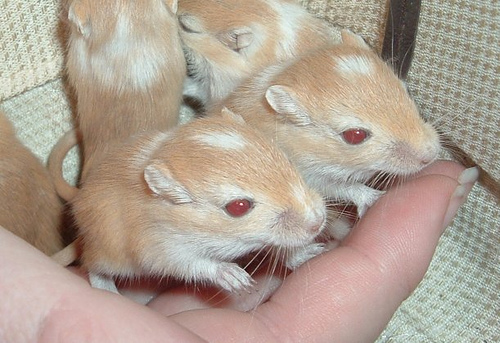
Depending on other recessive genes and whether they are spotted or not can make these colors more difficult to tell apart. A dark Fawn can look like a lightened Golden – and a dark Cream can look like a lightened Fawn.
This is why in the gerbil fancy – there isn’t a class for every one of the three shades – they all go in the same class. It doesn’t actually matter what they are genetically – it is what they look like that counts in a show.
Argente Fawn is the exact genetic partner for a Sapphire with the same colour and genetic patterns. Lilac is the equivalent of the Argente Golden and Dove that of the Argente Cream.
Pink Eyes in the population:
The gene that creates the ginger colour – the Pink-Eyed gene – works by changing all the pigment forming cells in a growing embryo stopping them making any ‘black’ colors. This results in the black being lost from the eyes (leaving them pink) and also has the effect of removing all the black tips from the hairs too leaving the gerbils totally ginger.
Basically an Argente gerbil is an Agouti gerbil with all its black pigment missing.
If does however, not affect the silver hairs – and so you can still see all the silver hairs by parting the coat of an Argente gerbil.
This gene has the same effect on a Black gerbil where all the black pigment is removed. However as the Black gerbil has already had all of its ginger coloring removed by the action of the [aa] genes – all that is left is the silver; and this is what creates the Lilac, Sapphire and Dove colors.
The actions of this gene is also associated with poor eyesight as these gerbils now have no protection from the sun and you can see straight into the blood vessels and tissues – hence the pink colour. The black pigment in the iris generally blocks out the harmful effects of the sun – but it isn’t there in gerbils with pink, ruby and red eyes.
As a result, over time the effects of sunlight will damage some of the delicate tissues in the eyes which are now unprotected.
I’m not sure it IS Argente Fawn yet?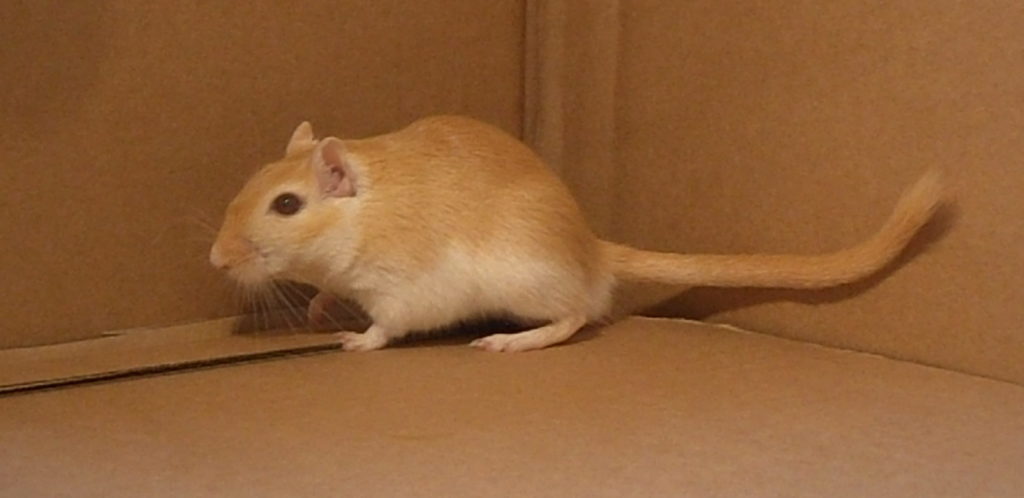
Argente Fawns can look somewhat like a Yellow Fox/Red-Eyed Honey or Red Fox/Saffron at first, but there are easy ways to tell them apart.
Yellow Fox/Red-Eyed Honey – unless it is spotted, a Yellow Fox will be bright ginger all over its body, and right down to its body – part the fur on its back to see the ginger colour underneath (see image top right).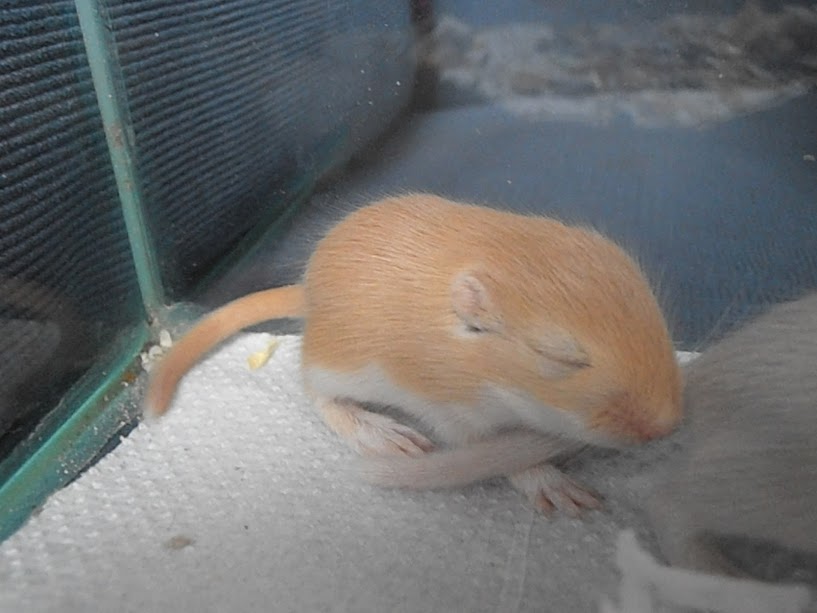
An Argente – due to the way it is made genetically – always has silver underfur clearly visible when you part the fur on their backs.
Argente gerbils also have far less white on them – unless spotted – but they don’t have the characteristic white eye ring of the ginger Foxes/Honeys. (see image middle right compared to the eye sof top right)
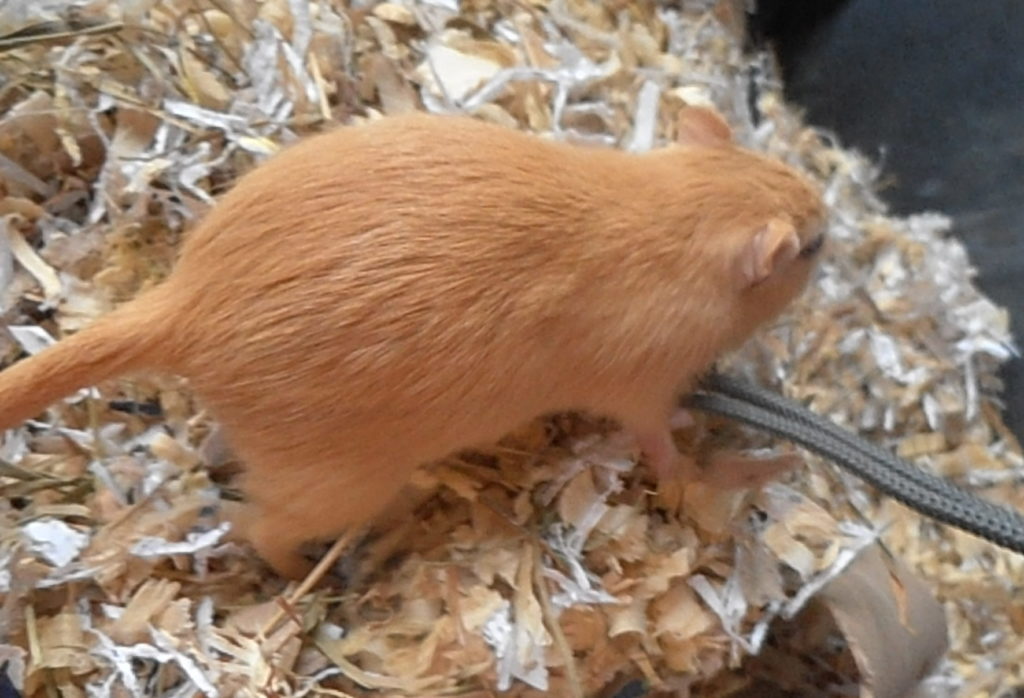 Red Fox/Saffron – Although also very ginger (see image bottom right) and displaying the white eye ring of the ginger Foxes/Honeys, a heavily spotted Red Fox can easily be mistaken for an Argente Cream – but it is all down to parting the hair again.
Red Fox/Saffron – Although also very ginger (see image bottom right) and displaying the white eye ring of the ginger Foxes/Honeys, a heavily spotted Red Fox can easily be mistaken for an Argente Cream – but it is all down to parting the hair again.
An Argente Fawn will be silver underneath where a Red Fox will be ginger from top to bottom.
The ginger gerbil group is one of the hardest to tell apart when you are new to the fancy – but once you learn the hair-parting trick, the eye rings and the higher demarcation line (which we took a while ourselves to catch on to) an Argente of any shade is totally easy to spot a mile off.
You have Argente Fawn gerbils you want to Breed?
Due to the prevalence of all the common genes needed to create an Argente, this colour is one of the most easily created gerbil colours in litters.
Genetics-wise, the genes for an Argente Fawn are quite ‘strong’ (strong in this instance means prevalent and dominant), that if you mate an Argente gerbil to any other gerbil on the agouti side, you will probably get Argente Fawns in the litter. Often a litter of Agoutis with one ginger pup is often an Argente Fawn.
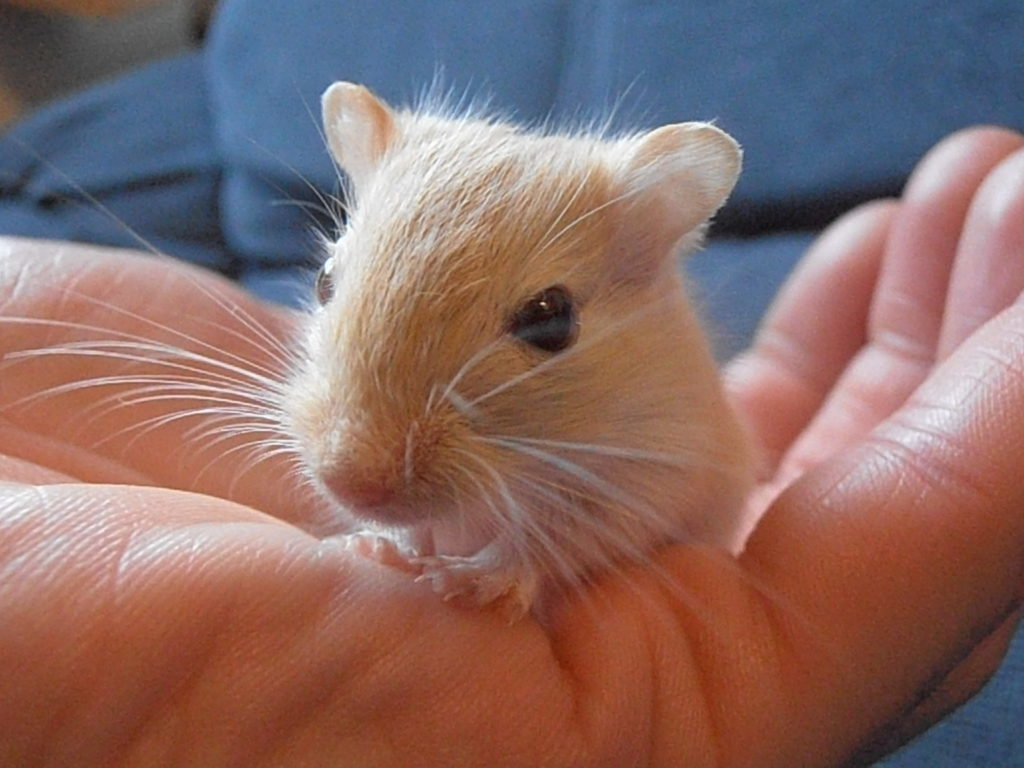
You want Argente Fawn Pups?
There are loads of different ways to get Argente Fawn pups in your litters depending on the colours you already have or know the genes for.
If you want 100% Argente Fawns in your litter you are out of luck. Argente Fawns can not breed true due to their needing different c genes in their genotype. Because they need both a dominant [C] and recessive [cᶜʰᵐ] at the same time – when you breed them together they will never get only these specific genes – they mix up.
As a result, breeding together two Argente Fawns together will produce the following pup colors:
- 50% – Argente Fawn
- 25% – Argente Golden
- 25% – PEW
You get the Pink-Eyed Whites (PEWs) due to a quirk of the colorpoint + pink eye gene combination. All gerbils with 2 colorpoint genes and 2 pink eye genes bleach out totally – leaving only white gerbils with overly pink eyes (not ruby or red – pink). It doesn’t matter what their original colour was (Red Fox, Yellow Fox, Lilac, etc) – this combination on top of all their other genes hides them all under a white coat – see our (genetically) colorpoint Argente below .
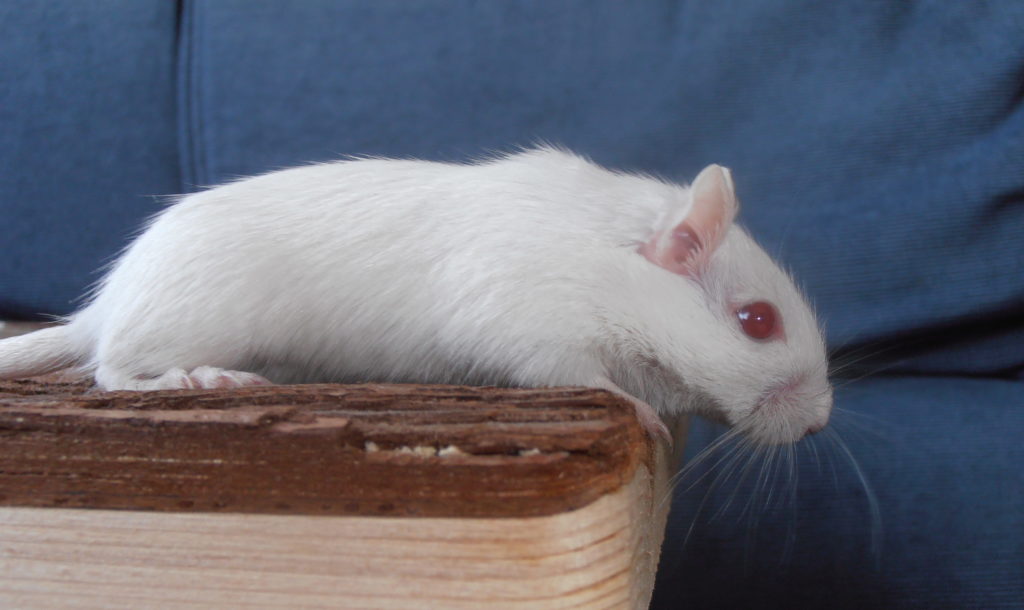
Regardless of whether you have two Argente Fawns already – you can still get a large percentage of them in your litters (amongst other colors) by doing one or all of the following things:
Only breed gerbils on the agouti side
Basically do not breed any self-based colours into your lines – this adding of the [aa] colours will drastically reduce the chances of you getting Argente Fawns (or anything on the agouti side of colours). Basically by excluding the recessive agouti gene [a] from the gene pool – you are doubling your chances of getting Argente.
Only breed gerbils with red/pink eyes
Basically breeding only pink-eyed gerbils means you will be eliminating all the dark-eyed colors (Polar Fox, Dark-Eyed Honey, etc) – which doubles the chances of you getting Argente pups instantly. Breeding an Argente Fawn to a Sapphire would be the perfect parents.
However, be careful not to use two gerbils with the same sets of recessives – as otherwise you will only get pups with those recessives and no Argente.
Always breed only one colorpoint in a pair
If you use two colorpoints you won’t get Argente Fawns in your litter obviously (as Argente Fawns are not colorpoints themselves (remember the PEWs above)), but by not using any colorpoints you are preventing any recessive genes at that locus getting into the gene pool reducing your chances of getting Argente Fawns to zero.
You can use any colorpoint colors for this either agouti-based or self-based – you just need to balance out the red eyes an [A*] combos with the parents if using dark-eyed or self colorpoints. Best choice would be PEWs to another pink-eyed agouti-based color – but do make sure they are PEWs (Pink-Eyed Whites – c*c*pp) not REWs (Ruby-Eyed Whites – aappuu) – as the REWs (Ruby-Eyed Whites) aren’t actually colorpoints.
Colorpoints can be Light (LCP) or ‘ordinary’ (CP) – where ordinary has two [cᶜʰᵐcᶜʰᵐ] genes – perfect for just Argente Fawns – whereas the Light versions only have one [cᶜʰᵐ] gene (the other is a cʰ gene). If you want only Argente Fawns – stick to the ordinary CPs for your breeding – however use the LCP colors if you also want Argente Cream pups in the same litters.
Don’t have Argente Fawn gerbils – but want them?
If you don’t have any Argente Fawn gerbils of your own but still want them – you could try one of the following plans to get them…
1) Breed any red-eyed agouti-based gerbil with a Sapphire ( – best)
2) Breed any red-eyed agouti-based gerbil with a Burmese gerbil* ( – could be good)
3) Breed any 2 red-eyed agouti-based gerbils (who don’t share genes) together ( – bit of a gamble**)
*The Burmese would need to carry the pink eye gene for this to work – but if it didn’t at least all your pups from his litters would now carry the gene you need for your Argente Fawns. A CP Agouti or CP Grey Agouti would be better here – but these can be harder to identify than a Burmese.
**It is possible that this could throw up your Argente Fawns due to the prevalence in most lines of the two genes you need – however, it isn’t guaranteed.
Argente Fawns are harder to get in a litter in the sense that they are one colour divided up. So not only do you need the genes to make the general Argente color – you also need the specific colorpoint gene in there to make them a Fawn (rather than a Golden or Cream).
Therefore, limiting all the other genes possible from a pairing and trying to avoid adding in any genes that aren’t needed to make an Argente Fawn will make your breeding more successful. By eliminating all the unnecessary genes (like non-agouti, underwhite, extension of yellow and Himalayan) the more chances you have of the remaining genes creating your chosen color.
If you can’t find the right gerbils for this – or you want to breed just what you have – then you can’t avoid these extras – but just as long as you know that the more genes you add in with your parents – the longer it will take to start seeing the color pups you actually want.
Either way, after the first round of breeding, you would have all the right genes at your disposal – you would just need to make sure you kept your records in order and plan ahead.
Then you can start having some Argente Fawn fun…
Don’t want Argente Fawn pups in your litters?
There are several ways you can be sure of NOT getting Argente Fawn pups in your litter:
Don’t breed gerbils with pink/ruby/red eyes
If neither parent has the pink eye gene in a double dose – you won’t get first round Argente gerbils – and if you do it will only be a 25% chance or less of being Argente Fawn. To rid your world of Argente completely – you would need to make sure one or both parents were double dominant for the [P] gene – so [PP] (which may need test breeding to determine).
If you only have one parent who is [PP] – there is a chance down the line – even if you only breed dark-eyed gerbils together that a pink-eyed pups could turn up – and it could be an Argente.
Use pairs of gerbils both carrying the same recessives
This would mean something like breeding two uwᵈ gerbils together (like an Apricot and a Red-Eyed Silver Nutmeg or a Grey Agouti and a White-Bellied Cream). If both parents do not carry the dominant [U] version of this gene – you can’t ever get Argente in your litters even if both are [pp]. You will always only produce [uwᵈuwᵈ] colors.
Breeding two gerbils that have double dominants at the C locus
An Argente Fawn needs a single recessive gene [c] locus – so breeding together gerbils who don’t have a recessive copies of that gene (i.e. they are CC) won’t ever create an Argente Fawn (they may however, create an Argente Golden).
Using any of the techniques drastically reduces the number of other gerbil colors you could get in your litters, so record keeping is important if you are planning to only breed certain colors. Test breeding and planning your line in advance are very important to this – and can help litters of colors that are harder to home or show.
For more information about Breeding for Color please do read on…